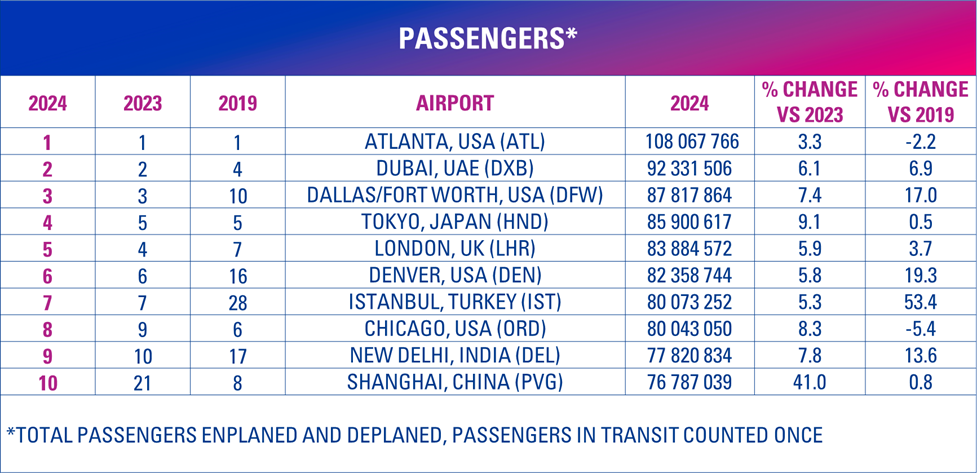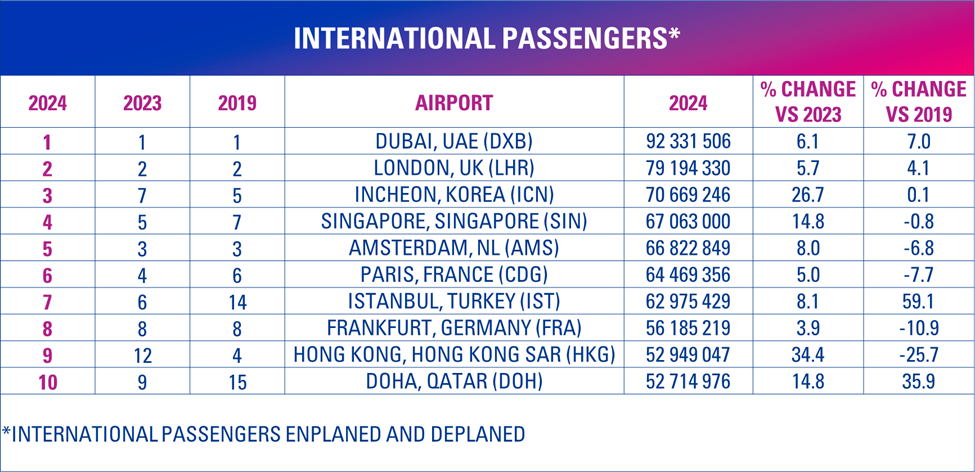
World's Busiest Airports Showcase Resilience Against Global Challenges: ACI
Airports Council International (ACI) World reveals the 2024 rankings, highlighting how leading airports have maintained their performance despite geopolitical uncertainties.
Airports Council International (ACI) World has unveiled the initial insights into the 2024 rankings of the busiest airports worldwide, underscoring their capability to thrive amid global uncertainties. Despite various geopolitical and economic challenges, these airports have retained their leading positions, positioning themselves for future expansion.
ACI World Director General Justin Erbacci stated, “Amid global challenges, the resilience of the world’s busiest airports shines. These hubs are vital arteries of trade, commerce, and connectivity. As air travel grows, ACI World stands ready to support its members, ensuring the smooth flow of people and goods that drive global economic, social, and cultural progress.”
Passenger Traffic Highlights
- Preliminary figures suggest that global passenger numbers in 2024 will approach 9.5 billion, marking a 9% increase from 2023 and a 3.8% rise compared to pre-pandemic levels (2019).
- The Top 10 busiest airports, contributing 9% of global traffic (855 million passengers), experienced an 8.8% increase from 2023 and an 8.4% rise from 2019 results (789 million pax).
- Hartsfield-Jackson Atlanta International Airport retains its top ranking, followed by Dubai International Airport and Dallas Fort Worth International Airport.
- Shanghai Pudong International Airport made the most significant leap in the Top 10, rising from 21st in 2023 to 10th in 2024, driven by expanded visa policies and increased international flights.
- Istanbul Airport and New Delhi International Airport remain strong contenders, benefitting from airline growth and enhanced global connectivity.
 Passenger Traffic Graph
Passenger Traffic Graph
 Airport Rankings
Airport Rankings
Addressing Global Uncertainty
The year 2024 presents significant uncertainties for global passenger growth, including evolving economic and geopolitical factors. Challenges such as supply chain disruptions and potential geopolitical tensions could affect flight operations, while looming tariffs may disrupt global trade, impacting international travel demand.
In 2025, global passenger traffic is expected to reach 9.9 billion with a year-on-year growth rate of 4.8%. Although demand remains strong, growth may slow as markets adjust from a recovery phase to long-term growth strategies. Key challenges such as economic uncertainty and capacity limitations will shape the future landscape of the airport industry.
Cargo Traffic Insights
- Air cargo volumes are projected to rise by 8.4% year-over-year, totaling over 124 million metric tonnes in 2024.
- The top 10 airports, accounting for 26% (32.3 million metric tonnes) of global cargo, experienced a 9.3% increase in 2024 compared to previous years.
- This surge is primarily tied to strong e-commerce demand and disruptions in maritime shipping.
- Hong Kong International Airport leads in cargo volumes, followed by Shanghai Pudong International Airport and Memphis International Airport.
Aircraft Movements Overview
- For 2024, global aircraft movements are estimated at 100 million, signifying a 4.3% increase from 2023.
- The Top 10 airports, which represent over 6% of global traffic, saw a 6.5% rise from their 2023 figures.
- Leading the pack is Hartsfield-Jackson Atlanta International Airport, alongside Chicago O’Hare International Airport and Dallas Fort Worth International Airport.
